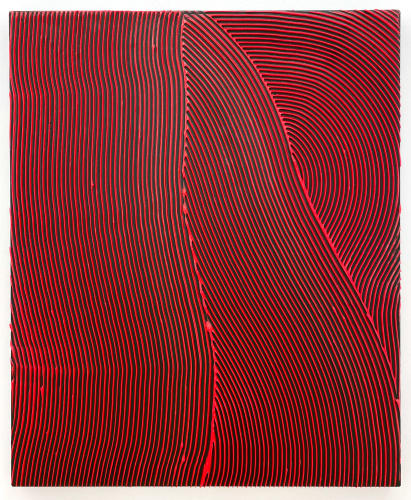What is painting? Let's ask the internet: "Painting is one of the classical genres of fine art. As a rule, it involves two-dimensional works, which, in contrast to drawing, is done by applying wet paint to a painting surface using a brush, spatula or other tools."
In preparation, Jakob Gasteiger applies his paint thickly to the surface of the painting and then removes it from the canvas with the help of a cardboard comb spatula he made himself, leaving the paint only where the comb has its indentations.
This procedure, as well as the result of the paintings, illuminates a conceptual-minimalist aspect of painting. The paint is not applied to the canvas gesturally, expressively and supposedly with a recognisable handwriting, no, it is removed in an anonymous mechanical act of painting, the gesture takes place solely in the movement of the comb and does not reveal the painter in his expression behind it. Gasteiger comments: "The comb spatulas I use are an anonymous tool, they enable me to work without a 'personal handwriting'."
And yet the resulting works are more than pure painting. They are border crossers between panel painting, sculpture and relief. When Gasteiger repeatedly mixes conventional sculpture materials (iron, glass, aluminium) into his paints, he brings the genres into their own coherent connection. It is an experimental approach to form, colour, space and material. This expansion of the concept of painting can certainly be described as conceptual asceticism.
In the new series of works shown at the bechter kastowsky gallery in Schaan, Gasteiger reaches deep into the paint pot. His works, which until now have been kept rather muted, burst into a radiance that has hardly been seen before. He boldly places his squeegee marks with neon yellow paint on blue primed canvases, lets bright orange shine on yellow and thus creates a radiance in the finished picture. Through the guidance of his comb, traces are created on the picture support, ranging from geometrically exact to curved patterns - freshly drawn Ratrak traces, as it were. If the viewer moves in front of these pictures, giving them the opportunity to appear differently from all sides, he will be amazed at how not only the colourfulness but also the surface changes: From velvety soft traces of colour, reminiscent of plush upholstery, to clear angular trickles.
Gasteiger's painting is multifaceted and picks up the viewer in its clarity and tranquillity - a kind of painting that could be observed in art history, for example, in the "Radical Painting" group. A representative of this type of painting, Joseph Marioni, for example, creates works on canvas that reveal their layers and meanings to the viewer "in the field of tension between colour, light and the body of the painting", "depending on the incidence of light and the position of the viewer".
What is painting now: a term that includes many facets of the panel painting, but in the present case of Jakob Gasteiger's new - colourful - series of works, inevitably involves the viewer in the experience in order to make the works created in series comprehensible and tangible.


